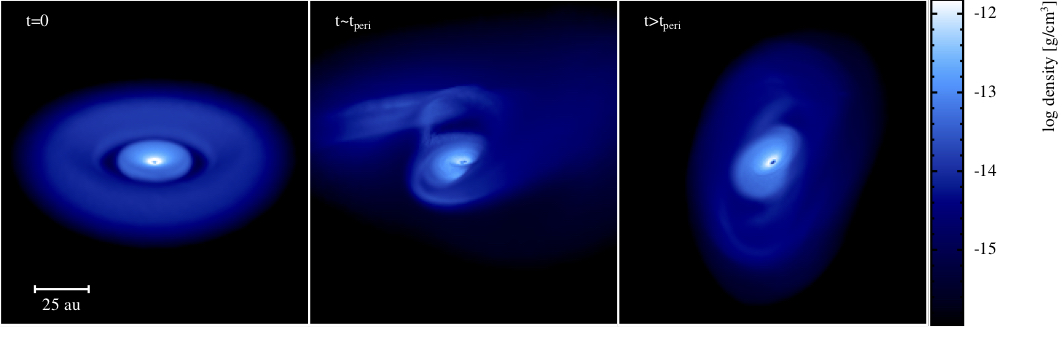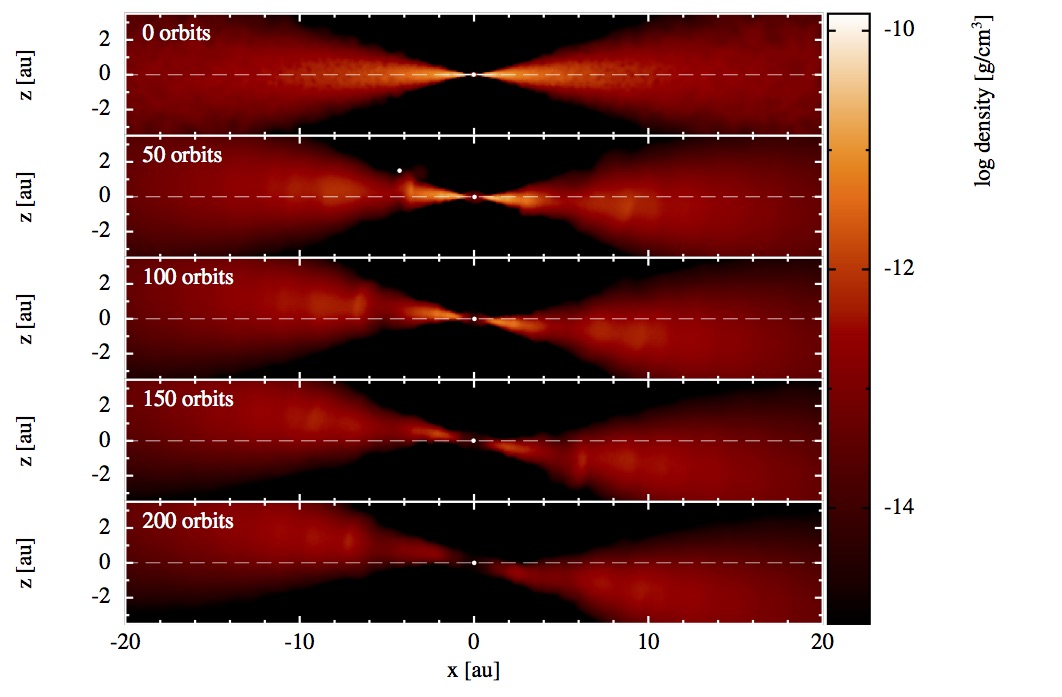The Bardeen-Petterson effect in accreting supermassive black-hole binaries: disc breaking and critical obliquity
The inspiral of supermassive black-hole binaries in gas-rich environment is driven by the presence of an accretion disc and viscous interactions tend to align the spin of the black holes with the orbital angular momentum of the disc. Recent work introduced a new iterative approach to describe the alignment process and the resulting non-linear evolution of the surrounding warped accretion disc. Their model predicted that black-hole spins reach either full alignment or a critical obliquity where solutions to the warp equations cease to exist. In this paper, we show that this critical region corresponds to the disc breaking phenomenon, where the disc is disrupted into two or more discrete sections. We use 3D hydrodynamical simulations to (i) recover the predictions of the semi-analytic model and (ii) unveil a richer phenomenology where the disc exhibits either unsuccessful, single and multiple breaks. We additionally identify hydrodynamic effects such as spiral arms that are able to stabilise the disc against breaking beyond criticality. Our results show that when disc breaking occurs, the ability of black holes and disc to align is compromised and in some cases even prevented as the binary inspirals.
Spirals, shadows and precession in HD 100453 - II. The hidden companion
The protoplanetary disc HD 100453 exhibits a curious combination of spirals, shadows, and a relative misalignment between the observed outer disc and inferred inner disc. This disc is accompanied by a secondary star on a bound orbit exterior to the disc. Recent observations have suggested there may be an additional low-mass companion residing within the disc inner cavity. In our companion paper, the orbit of the secondary was shown to be misaligned by 61° to the plane of the outer disc. Here, we investigate the properties of the inner companion and the origin of the misalignment between the inner and outer discs. In our proposed model, the misalignment observed between the outer and inner disc arises naturally as a result of the misaligned outer companion driving the outer disc to precess more rapidly than the inner disc.
Rocking shadows in broken circumbinary discs
We use three dimensional simulations with coupled hydrodynamics and Monte Carlo radiative transfer to show that shadows cast by the inner disc in broken circumbinary discs move within a confined range of position angles on the outer disc. Over time, shadows appear to rock back and forth in azimuth as the inner disc precesses. The effect occurs because the inner disc precesses around a vector that is not the angular momentum vector of the outer disc. We relate our findings to recent observations of shadows in discs.
Flyby-induced misalignments in planet-hosting discs
We now have several observational examples of misaligned broken protoplanetary discs, where the disc inner regions are strongly misaligned with respect to the outer disc. Current models suggest that this disc structure can be generated with an internal misaligned companion (stellar or planetary), but the occurrence rate of these currently unobserved companions remains unknown. Here we explore whether a strong misalignment between the inner and outer disc can be formed without such a companion. Using a flyby on a misaligned orbit, we demonstrate that large misalignments may be generated without a misaligned inner companion however they are not long lasting.

Scattered light shadows in warped protoplanetary discs
Here we consider the observable consequences of warped discs. We use 3D numerical simulations of a protoplanetary disc warped by a misaligned planet and use the radiative transfer code MCFOST to generate scattered light images. We find that even moderate mass planets at mild inclinations are enough to produce an observable warp, and that the warp in the outer disc generated by the misaligned planet causes an asymmetry in the outer disc that appears like an asymmetric shadow. Finally, we apply our model to the TW Hya system to determine if that system has a misaligned planet.
Warping a protoplanetary disc with a planet on an inclined orbit
Recent observations of several protoplanetary discs have found evidence of departures from flat, circular motion in the inner regions of the disc. One possible explanation for these observations is a disc warp, which could be induced by a planet on a misaligned orbit. We present three-dimensional numerical simulations of the tidal interaction between a protoplanetary disc and a misaligned planet.

On the Papaloizou-Pringle instability in tidal disruption events
We demonstrate that the compact, thick disc formed in a tidal disruption event may be unstable to non-axisymmetric perturbations in the form of the Papaloizou-Pringle instability. We show this can lead to rapid redistribution of angular momentum that can be parametrized in terms of an effective Shakura-Sunyaev α parameter. For remnants that have initially very weak magnetic fields, this may be responsible for driving mass accretion prior to the onset of the magnetorotational instability. We thus identify a method by which the torus formed in tidal disruption event may be significantly accreted before the magnetorotational instability is established.
Apsidal precession, disc breaking and viscosity in warped discs
We demonstrate the importance of general relativistic apsidal precession in warped black hole accretion discs by comparing three-dimensional smoothed particle hydrodynamic simulations in which this effect is first neglected, and then included. If apsidal precession is neglected, we confirm the results of an earlier magnetohydrodynamic simulation which made this assumption, showing that at least in this case the α viscosity model produces very similar results to those of simulations where angular momentum transport is due to the magnetorotational instability. Including apsidal precession significantly changes the predicted disc evolution. For moderately inclined discs thick enough that tilt is transported by bending waves, we find a disc tilt which is non-zero at the inner disc edge and oscillates with radius, consistent with published analytic results. For larger inclinations, we find disc breaking.
On the Bardeen-Petterson Effect
We investigate the effect of black hole spin on warped or misaligned accretion discs - in particular (i) whether or not the inner disc edge aligns with the black hole spin and (ii) whether the disc can maintain a smooth transition between an aligned inner disc and a misaligned outer disc, known as the Bardeen-Petterson effect. Using high-resolution 3D simulations of black hole accretion discs, we recover tilt oscillations at small and moderate inclinations provided both Lense-Thirring and Einstein precession are present, sufficient resolution is employed, and provided the disc is not so thick so as to simply accrete misaligned. We also show that discs inclined by more than a few degrees in general steepen and break rather than maintain a smooth transition, again in contrast to previous findings, but only once the disc scaleheight is adequately resolved. Finally, we find that when the disc plane is misaligned to the black hole spin by a large angle, the disc `tears' into discrete rings which precess effectively independently and cause rapid accretion, consistent with previous findings in the diffusive regime.